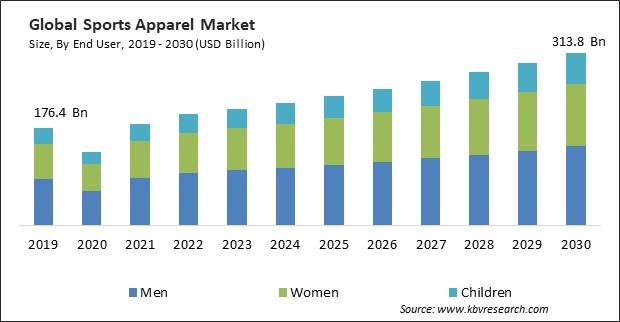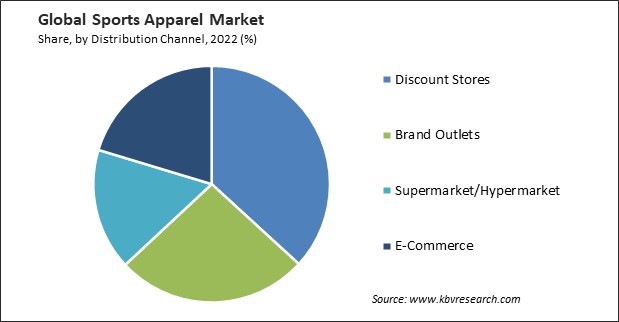The Global Sports Apparel Market size is expected to reach $313.8 billion by 2030, rising at a market growth of 5.7% CAGR during the forecast period. In the year 2022, the market attained a volume of 4,745.2 million units, experiencing a growth of 6.2% (2019-2022).
Online retailing breaks down geographical barriers, allowing consumers to access worldwide sports apparel brands and styles. Consequently, the E-commerce segment captured $41,097.7 million revenue in the market in 2022. E-commerce platforms offer consumers the convenience of shopping from the comfort of their homes or on the go. This accessibility especially appeals to individuals with busy lifestyles, as they can browse and purchase the apparels anytime, 24/7. This global reach has expanded the market and introduced consumers to diverse products and designs that may not be available locally. Some of the factors impacting the market are Growing health and fitness awareness, Increasing trends of athleisure wear and Decreased consumer spending due to economic downturns.

Consumers are increasingly seeking clothing that looks good and enhances their performance during physical activities. They are designed with specific features such as moisture-wicking, breathability, and flexibility, providing comfort and functionality that traditional clothing may lack. Athleisure wear has experienced a surge in popularity, causing a convergence of athletic apparel and casual attire. The global focus on health and wellness has increased the emphasis on physical fitness and exercise. As individuals prioritize their well-being, they are more likely to invest in suitable apparel that aligns with their fitness goals. The rise of specialized sports and fitness activities, such as running, yoga, and cross-training, has created a demand for these apparels tailored to the specific requirements of each activity. Brands often develop specialized lines to cater to these niche markets. Fabric design and technological advancements have contributed to the production of athletic apparel that is both functional and fashionable. The combination of functionality and fashion appeals to consumers who want performance and aesthetics in their activewear. These aspects will increase the demand for these apparels in the coming years.
However, economic downturns often lead to decreased consumer confidence and disposable income. In such circumstances, consumers are more likely to cut back on non-essential or discretionary spending, and sports apparel falls into this category. Items considered non-essential, such as athletic clothing for fashion rather than immediate need, may experience a decline in demand. High-end brands, which often command premium prices, may face challenges during economic downturns. The revenue of premium and designer, companies, may be impacted as consumers choose more cost-effective alternatives or postpone discretionary sales. Retailers may face challenges related to excess inventory during economic downturns if they overestimate consumer demand. Clearance sales and discounting to manage inventory levels can impact profit margins for both retailers and sports apparel brands. As a result, these factors can hamper the growth of the market.
Based on distribution channel, the market is divided into supermarket/hypermarket, brand outlets, e-commerce, and discount stores. In 2022, the brand outlets segment witnessed a substantial revenue share in the market. Brand outlets physically manifest a brand's identity, allowing consumers to immerse themselves in the brand experience. Company-owned stores offer brands greater control over their image and presentation. By managing the entire retail environment, brands can ensure that the store ambiance, staff interactions, and product displays align with the desired brand image and messaging. These aspects will help in the expansion of the segment.

Based on end user, the market is segmented into men, women, and children. The men segment held the largest revenue share in the market in 2022. The broader trend of casualization in fashion has influenced men's clothing preferences. The shift towards more relaxed and comfortable styles in work and leisure settings has contributed to incorporating sports-inspired elements into everyday wardrobes. The global sports and fitness culture, propelled by social media, fitness influencers, and sports celebrities, significantly impacts men's fashion choices. These factors will boost the demand in the segment.
| Report Attribute | Details |
|---|---|
| Market size value in 2022 | USD 202.2 Billion |
| Market size forecast in 2030 | USD 313.8 Billion |
| Base Year | 2022 |
| Historical Period | 2019 to 2021 |
| Forecast Period | 2023 to 2030 |
| Revenue Growth Rate | CAGR of 5.7% from 2023 to 2030 |
| Number of Pages | 290 |
| Number of Tables | 530 |
| Quantitative Data | Volume in Million Units, Revenue in USD Billion, and CAGR from 2019 to 2030 |
| Report coverage | Market Trends, Revenue Estimation and Forecast, Segmentation Analysis, Regional and Country Breakdown, Porter’s 5 Forces Analysis, Company Profiling, Companies Strategic Developments, SWOT Analysis, Winning Imperatives |
| Segments covered | Distribution Channel, End User, Region |
| Country scope |
|
| Companies Included | Under Armour, Inc., Adidas AG, Nike, Inc., PUMA SE (Groupe Artémis S.A.), Ralph Lauren Corporation, FILA Holdings Corporation, Lululemon Athletica, Inc., New Balance Athletics, Inc., Columbia Sportswear Company and ASICS Corporation |
| Growth Drivers |
|
| Restraints |
|
By region, the market is segmented into North America, Europe, Asia Pacific, and LAMEA. The Asia Pacific segment procured the highest revenue share in the market in 2022. In the Asia-Pacific region, the middle class is experiencing significant growth. As incomes rise, consumers in countries like China, India, and Southeast Asian nations have more disposable income to spend on lifestyle and fitness-related products, including these apparels. Urban dwellers are more inclined to engage in fitness activities, and it becomes an integral part of their wardrobe, reflecting a blend of comfort and style. These factors will fuel the demand in the segment.
Free Valuable Insights: Global Sports Apparel Market size to reach USD 313.8 Billion by 2030
The market research report covers the analysis of key stake holders of the market. Key companies profiled in the report include Under Armour, Inc., Adidas AG, Nike, Inc., PUMA SE (Groupe Artémis S.A.), Ralph Lauren Corporation, FILA Holdings Corporation, Lululemon Athletica, Inc., New Balance Athletics, Inc., Columbia Sportswear Company and ASICS Corporation.
By Distribution Channel (Volume, Million Units, USD Billion, 2019-2030)
By End-user (Volume, Million Units, USD Billion, 2019-2030)
By Geography (Volume, Million Units, USD Billion, 2019-2030)
This Market size is expected to reach $313.8 billion by 2030.
Growing health and fitness awareness are driving the Market in coming years, however, Decreased consumer spending due to economic downturns restraints the growth of the Market.
Under Armour, Inc., Adidas AG, Nike, Inc., PUMA SE (Groupe Artemis S.A.), Ralph Lauren Corporation, FILA Holdings Corporation, Lululemon Athletica, Inc., New Balance Athletics, Inc., Columbia Sportswear Company and ASICS Corporation.
In the year 2022, the market attained a volume of 4,745.2 million units, experiencing a growth of 6.2% (2019-2022).
The Discount Stores segment is leading the Market, by Distribution Channel in 2022; thereby, achieving a market value of $109.4 Billion by 2030.
The Asia Pacific region dominated the Market, by Region in 2022, and would continue to be a dominant market till 2030; thereby, achieving a market value of $109,149 Million by 2030.
Our team of dedicated experts can provide you with attractive expansion opportunities for your business.

